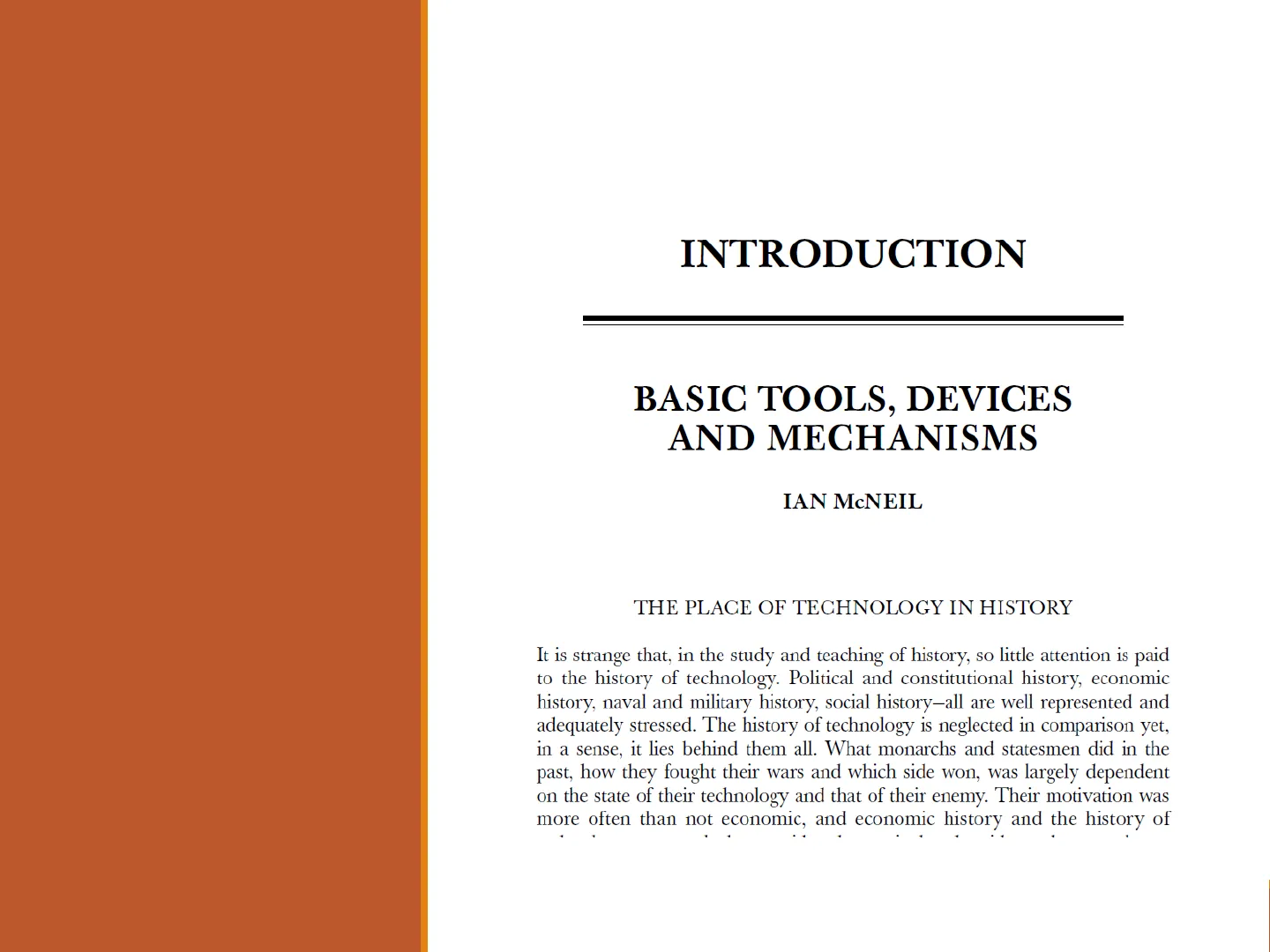Lesson 2: Seven technological ages of man, Università Politecnica Delle Marche
Slides from Università Politecnica Delle Marche about Lesson 2. Seven technological ages of man. The Pdf explores the technological ages of humanity, distinguishing between inventions and innovations in economic history, including a timeline of technological revolutions. This University-level Pdf on Economics is suitable for self-study.
Mostra di più16 pagine


Visualizza gratis il Pdf completo
Registrati per accedere all’intero documento e trasformarlo con l’AI.
Anteprima
Technology and History
Lesson 2. Seven technological ages of man Source: Storage plant. UNIVERSITÀ POLITECNICA DELLE MARCHE - FACOLTÀ DI ECONOMIA «GIORGIO FUÀ» - ECONOMIC HISTORY OF TECHNOLOGICAL CHANGE 1Technology and history UNIVERSITÀ POLITECNICA DELLE MARCHE - FACOLTÀ DI ECONOMIA «GIORGIO FUÀ» - ECONOMIC HISTORY OF TECHNOLOGICAL CHANGE INTRODUCTION BASIC TOOLS, DEVICES AND MECHANISMS IAN McNEIL THE PLACE OF TECHNOLOGY IN HISTORY It is strange that, in the study and teaching of history, so little attention is paid to the history of technology. Political and constitutional history, economic history, naval and military history, social history-all are well represented and adequately stressed. The history of technology is neglected in comparison yet, in a sense, it lies behind them all. What monarchs and statesmen did in the past, how they fought their wars and which side won, was largely dependent on the state of their technology and that of their enemy. Their motivation was more often than not economic, and economic history and the history of 2Technology and history Technology has been neglected for a long time, in historiographical terms. Technology is one of the main explanatory factors of economic evolution; but technology can be understood either as the outcome of nature, or as human intervention. Human intervention can be guided by
- aesthetic taste
- social incentives
- use
- achieving a goal
- working less
- spending less for a product of equivalent quality (lower adjusted-quality costs)
Social and economic history (SHE) takes all these factors into account UNIVERSITÀ POLITECNICA DELLE MARCHE - FACOLTÀ DI ECONOMIA «GIORGIO FUÀ» - ECONOMIC HISTORY OF TECHNOLOGICAL CHANGE
Technology and Science
3Technology and science Science deals with investigating the natural laws of nature. It presupposes a set of codified knowledge. Technology investigates the connection between scientific knowledge and the practical creation of tools and processes capable of solving practical problems. It may be independent of the acquisition of specific scientific knowledge, but it is always the result of human creativity. Time e spaces: during the second industrial revolution an inversion between science and technology occurred: During the 19th century, technological innovation became increasingly connected to the institutional organization of scientific knowledge. UNIVERSITÀ POLITECNICA DELLE MARCHE - FACOLTÀ DI ECONOMIA «GIORGIO FUÀ» - ECONOMIC HISTORY OF TECHNOLOGICAL CHANGE
Inventions in Economics
4Inventions «Economics is the science which studies human behaviour as a relationship between ends and scarce means which have alternative uses» (Lionel Robbins, 1935) Standard economics has difficulty explaining technological change, because it has to explain exactly what is taken as a starting point. UNIVERSITÀ POLITECNICA DELLE MARCHE - FACOLTÀ DI ECONOMIA « GIORGIO FUÀ» - ECONOMIC HISTORY OF TECHNOLOGICAL CHANGE
Schumpeter's Theory of Economic Development
5Inventions Theorie der wirtschaftlichen Entwicklung. Dr. Joseph Schumpeter .. Letpulg IM2 Schumpeter's Theory of Economic Development (1912) distinguishes between innovations and inventions. Invention does not necessarily imply its adoption. That is, the economic (and social-historical) necessity of an invention effectively makes it an innovation. Diffusion occurs when an innovation spreads in an economic sector (agriculture, industry, services) and, more specifically, speaking of the secondary sector, when an innovation spreads in an industry, then from one industry to another, then expands beyond geographical boundaries. Innovations are at the center of capitalism evolution UNIVERSITÀ POLITECNICA DELLE MARCHE - FACOLTÀ DI ECONOMIA «GIORGIO FUÀ» - ECONOMIC HISTORY OF TECHNOLOGICAL CHANGE
Inventions and Innovations
6Inventions/innovations T.H.E LEVEROF RICHES Mokyr suggests that this division be blurred. To be adapted to other geographical and economic contexts, inventions require modifications and improvements that can be considered inventions rather than innovations. > An invention can be defined as an increase in the overall technological knowledge of a given society. Innovations are all practices aimed at bridging the gap between best practices (inventions) and average practices. Inventions and innovations are complements. Without inventions, innovations would lead to diminishing returns and stagnation. Without innovations, inventors would have little interest in continuing their work because they would have little economic incentive (application in production processes reduced or cancelled). Technological Creativity and Economic Progress J.O .E.L M.O.K.Y.R UNIVERSITÀ POLITECNICA DELLE MARCHE - FACOLTÀ DI ECONOMIA «GIORGIO FUÀ» - ECONOMIC HISTORY OF TECHNOLOGICAL CHANGE
Technological Creativity and Social Factors
7Inventions/innovations T.H.E LEVEROF RICHES For these reasons, technological creativity is connected to individual factors (as the inventor is one person) and social factors (innovations depend on institutions, markets, culture, and other social aspects). Technological Creativity and Economic Progress J.O .E.L M.O.K.Y.R UNIVERSITÀ POLITECNICA DELLE MARCHE - FACOLTÀ DI ECONOMIA «GIORGIO FUÀ» - ECONOMIC HISTORY OF TECHNOLOGICAL CHANGE
Two Revolutions and Historical Ages
8Two Revolutions (and more?) ERS TE Neolithic Revolution Industrial Revolution Bronze Age Iron Age Classical Antiquity Age Age Early MA Modern IR IR Age 10.000BC 8.000 BC 3200-3100 BC 1100 BC V Cent. BC III Cent AD 476 AD VII Cent AD 1000 ca. AD 1348 AD 1453-1492 AD 1760 1830 1860 1950-80 2010s Industrial Societies Mid 4th mill. BC Uruk Agrarian Societies Hunting & Gathering Societies UNIVERSITÀ POLITECNICA DELLE MARCHE - FACOLTÀ DI ECONOMIA «GIORGIO FUÀ» - ECONOMIC HISTORY OF TECHNOLOGICAL CHANGE 9 Second Ind. Revolution 3rd 4th Early Middle High Middle LateTwo revolutions An overall view. Let's start with the major breakthroughs, accompanied by a technological revolution:
Neolithic Revolution Overview
- starting from 8500 BC
- birth of agriculture
Industrial Revolution Overview
- starting from 1760
- birth of modern industry
UNIVERSITÀ POLITECNICA DELLE MARCHE - FACOLTÀ DI ECONOMIA «GIORGIO FUÀ» - ECONOMIC HISTORY OF TECHNOLOGICAL CHANGE
Neolithic Revolution Details
10Neolithic Revolution starting from 8500 BC more efficient use of (solar energy) (man and crops) birth of agriculture and sedentarisation animal domestication foodstuffs on a continuous basis tools change in family and demographic structure of the group greater food availability (phisical presence of safe food): food security? UNIVERSITÀ POLITECNICA DELLE MARCHE - FACOLTÀ DI ECONOMIA «GIORGIO FUÀ» - ECONOMIC HISTORY OF TECHNOLOGICAL CHANGE
Neolithic Revolution Impact
11Neolithic Revolution Hunting & Gathering Plants & animals Domestication Agriculture & Anim. Husbandry (+ Herding) VIAIND ASITA POLITEZ Food Surplus and its storage Sedentarisation Animal viruses mutation systematic gathering and reproduction of plants growth conditions + Increase in pc births Epidemics (+ rel. immunization) Population growth Specialisation and social stratification Technologies (productive, military, of communication, etc.) DELLE MARCH Accumulation . Social complexity (codified laws, State, social hierarchies) UNIVERSITÀ POLITECNICA DELLE MARCHE - FACOLTÀ DI ECONOMIA «GIORGIO FUÀ» - ECONOMIC HISTORY OF TECHNOLOGICAL CHANGE 12 livestock for labor and products Per capita land requirement: H&G: 250 he.av.(50-1000 he.) Agric .: < 10 he.Industrial Revolution According to some historians, it has its roots in European reality (municipal "revolution" and scientific "revolution") new energy sources:
- fossils (the result of storing solar energy over a very long period of time)
- inanimate, whose consumption can be increased in the short term but is limited overall;
- transformation of heat into motion; widespread use of machines powered by mechanical energy expanding output widespread use of materials that are not normally found in nature. factory system:
- division of labor, discipline, specialized machinery; centralization of the population and urbanization.
UNIVERSITÀ POLITECNICA DELLE MARCHE - FACOLTÀ DI ECONOMIA «GIORGIO FUÀ» - ECONOMIC HISTORY OF TECHNOLOGICAL CHANGE
Roots of Industrial Revolution
13Roots of industrial revolution Italian city communes revolution (11th - 13th century)
- Emergence of a mercantile and manufacturing society;
Scientific Revolution (17th century)
- Utilitarian and mechanistic imprint, which spreads in different places and times;
Industrial Revolution (from the 18th century)
- Ideals of practicality and profit;
How many industrial revolutions?
- Emergence of three social groups: Neal-Cameron prefer to use the concept of modern industry.
- merchants
- notaries, doctors,
- artisans
- Progressive attention to observation, measurement A question of definitions and concepts that identify the changes that have occurred. Fonte: Cipolla 2002. UNIVERSITÀ POLITECNICA DELLE MARCHE - FACOLTÀ DI ECONOMIA «GIORGIO FUÀ» - ECONOMIC HISTORY OF TECHNOLOGICAL CHANGE
Industrial Revolutions Timeline
14Two Revolutions (and more?) JERS EC Industrial Revolution Second Ind. Revolution 3rd 4th Early Middle High Middle Late Early MA Modern IR IR Age Age Age 10.000 BC 8.000 BC 3200-3100 BC 1100 BC V Cent. BC III Cent AD 476 AD VII Cent AD 1000 ca. AD 1348 AD 1453-1492 AD 1760 1830 1860 1950-80 2010s Industrial Societies Mid 4th mill. BC Uruk Agrarian Societies Hunting & Gathering Societies UNIVERSITÀ POLITECNICA DELLE MARCHE - FACOLTÀ DI ECONOMIA «GIORGIO FUÀ» - ECONOMIC HISTORY OF TECHNOLOGICAL CHANGE 15 Neolithic Revolution Bronze Age Iron Age Classical Antiquity
Seven Technological Ages
Seven ages overlapping
- the era of nomadic hunter-gatherers
- the Metal Ages of the archaeologist
- the first Machine Age (late middle ages)
- the beginnings of quantity production when, with the early application of steam power
- the full flowering of the Steam Age
- the spread of the internal combustion engine
- the present Electrical and Electronic Age
UNIVERSITÀ POLITECNICA DELLE MARCHE - FACOLTÀ DI ECONOMIA «GIORGIO FUÀ» - ECONOMIC HISTORY OF TECHNOLOGICAL CHANGE 16